Magarey Medal 2024: Meet the new SA Football Hall of Fame inductees
There are many good players in the SANFL, some great players and then there are these four men, who have just joined the pantheon of SA footy legends.
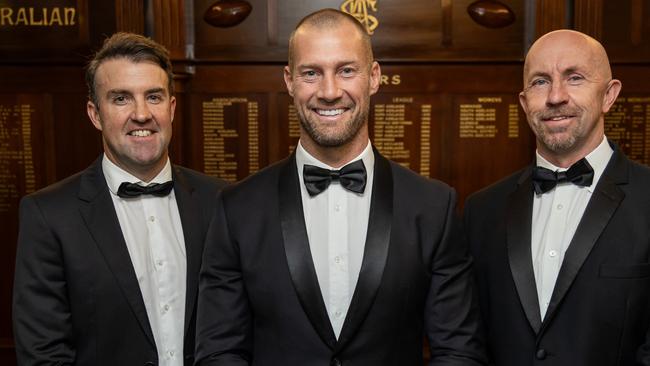
Sport
Don't miss out on the headlines from Sport. Followed categories will be added to My News.
Sturt legend and Australian Football Hall of Famer John Halbert played on some of the game’s greatest centremen.
He rates North Adelaide’s Lyle Griffin as the toughest of them all to beat.
“I stood him in the middle and he was tough, really tough to beat,’’ Halbert said.
“Some centremen used to go kick chasing, the likes of Lindsay Head (West Torrens) and Jimmy Deane (South Adelaide) were wonderful players and really tough opponents but you always had a chance playing against them because they used to go ball hunting and run all over the ground.
“But Griffin was a different sort, he was more like me, a stay at home centreman who worked mainly around the centre area.
“He was a very, very good player who was hard to get a kick against because apart from being very talented he was very disciplined. He didn’t give you a lot of space.
“That was my recollection of him.’’
Halbert, who played 244 games and kicked 253 goals from 1955-68 and won the 1961 Magarey Medal and finished runner-up three times, stood Griffin at the start of his career and the back end of the Rooster’s.
Griffin played for North from 1946-57.
“When I stood him I took an interest to find out more about him and discovered that while he had proven his worth at North Adelaide and the state team, he had been good enough in that era of football to be named in the All Australian team, as it was picked then,’’ Halbert said.
“That’s how good he was.’’
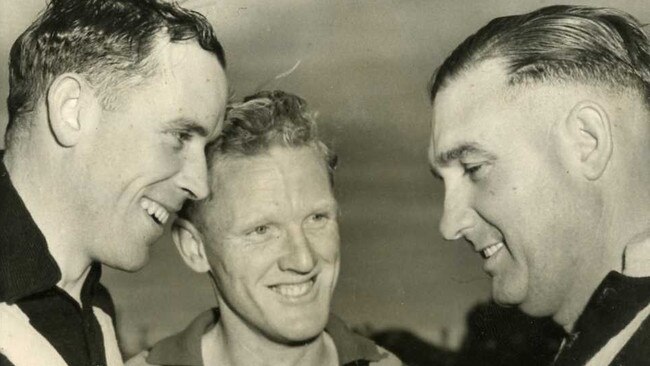
Griffin was twice selected in the ‘Sporting Life’ Team of the Year – in 1951 and 1952 – the equivalent of the modern day All Australian side.
He played 179 games and kicked 40 goals for North and represented SA 11 times – no mean feat when his competition included Head, Deane, Halbert and Port Adelaide Magarey Medallist Dave Boyd.
Griffin captained the Roosters for two seasons in 1956-57 and enjoyed his finest season in 1952 when he won a premiership, the club best and fairest, made The Advertiser SANFL Team of the Year, along with his national team of the year honour, and was runner-up for the Magarey Medal behind Sturt’s Len Fitzgerald.
He was also one of North’s best in its then record-breaking 108-point grand final annihilation of Norwood.
Illustrating his team-first approach is that Griffin was voted as North’s best team man in 1956, most unselfish in 1957, most effective player in 1948 and 1954 and most consistent in 1951, 1953 and 1955.
“He was the one I had the greatest difficulty getting kicks against because he had a good defensive side to his game as well as a good attacking side,’’ Halbert said.
“I remember being asked quite distinctly during my playing career who was the hardest centreman I stood and I replied Griffin because he went hard at the ball and he was hard to move off it.
“He was there to do a job and he did it very well.’’
Griffin, who is a member of North’s Hall of Fame, died in 2017, aged 89.
Laird’s magnificent seven puts him among SANFL greats
Roy Laird has never been one for personal fanfare.
But his coaching record stands with the best of them.
In the rich history of the SANFL, only the legendary John Cahill, Jack Oatey and Fos Williams have won more premierships as a coach.
Cahill (Port Adelaide) and Oatey (Norwood and Sturt) won a record 10 flags while Williams coached the Magpies to nine.
Laird sits just behind them with seven, having steered Central District to premierships from 2003-05 and 2007-10.
It is an amazing record for a man who has always had a team-first mentality and has never sought the public limelight.
His coaching record is so special that it has landed him in the South Australian Football Hall of Fame.
“Getting this honour is a bit hard to comprehend, to be honest, because I’ve never thought about something like this,’’ Laird told The Advertiser.
“I’ve just always got on with things and appreciated the opportunities I’ve had through a football club (Central) and competition (the SANFL) that I have supported since 1979.
“I started barracking for Central in ‘79 when going to games gave me an incredible buzz.
“It was exciting to walk into SANFL grounds, the competition and grounds were on par with the VFL, and I was caught up in it.
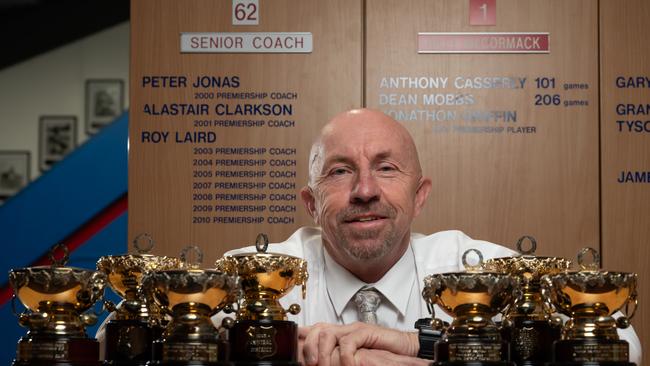
“Then to be able to have the good fortune of first playing and then later coaching the club I had supported was very exciting and something I had never dreamt of.
“So I am indebted to the SANFL for putting on the show and my club and the players I played with and coached along the way.’’
Laird played 87 league games for the Bulldogs from 1989-97 becoming one of the most successful coaches in SANFL history.
He coached Central’s reserves to the 2002 flag before replacing current North Melbourne coach Alastair Clarkson as league coach the following season.
Laird led the Dogs to a league premiership – only their third in history following their triumphs in 2000 and 2001 – in his first year at the helm and incredibly won flags in his first three years in charge.
After finishing runner-up to Woodville-West Torrens in 2006, Central and Laird repeated the premiership dose from 2007-10 in a golden era for the club.
Laird retired from SANFL coaching at the end of 2019 after 17 years as Bulldogs’ league coach with seven flags, nine grand final appearances and having missed the major round only three times – in 2014, 2018 and 2019.
It was an incredible run for a local kid who went to Elizabeth Vale Primary School, played soccer for Elizabeth Vale Soccer Club and grew up idolising the Dogs before getting his dream job.
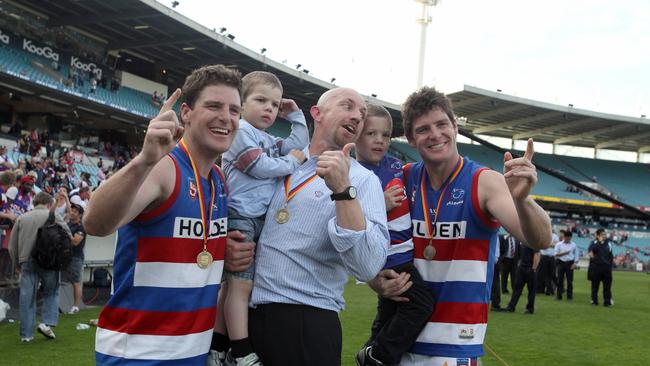
So what was the secret to being such a successful SANFL coach?
“I fell into a great group of players,’’ he said in typically selfless fashion.
“It was just uncanny really how it all came together, how a group of players came together to form an incredible bond.
“In some ways we used to cringe at some of their night habits, socially, but it all played a part in the group being really tight.
“By having a bit of success early in the piece, the recognition the players got in the northern suburbs was huge and that just fed the appetite of the guys, many of whom were just pure competitors.
“So in a sense it was reasonably easy to keep them backing up because they were already motivated and you just needed to keep them fit, applying themselves and watch out for any complacency, not that there was ever too much of that.’’
The great Central teams of the 2000s were led by star Gowans’ twins, Chris and James, current coach Paul Thomas, Daniel Healy, Matthew Slade and Ian Callinan.
But Laird said “everyone at the club played their role’’.
“Our coaching staff did a great job but we were never interfered with by the board, they just got on with their work and did it very well,’’ he said.
“It was just a club where everyone knew their roles and did them to the best of their ability and it allowed us to sneak out a bit of success for a while.’’
Persistence pays for Sheedy
Jade Sheedy’s story is one of persistence and “gritty determination’’.
Once believing he was too small and skinny and not good enough to play football, the New South Wales country kid contemplated giving the game away at 16.
Now he is a member of the South Australian Football Hall of Fame.
“It feels a bit embarrassing, to be fair,’’ Sheedy said of the glittering honour.
“It doesn’t sit quite right with me because of the journey I’ve taken, which is a bit different to most.
“I developed late, grew late, used to sit on the bench a fair bit back in the country, never made any representative sides, never won any individual awards and at one stage – because I wasn’t very good – thought footy probably wasn’t for me.
“Then you grow a bit, mature a bit, put on a bit of size and get a bit fitter and then things start to click.’’
Click they did.
Born in Tumut, which sits in the western foothills of the NSW Snowy Mountains, and moving to Gol Gol on the banks of the River Murray with his family at age five, Sheedy was playing in Mildura’s Sunraysia League before thinking he would give the game away and spend more time on the tennis court and water skiing.
But he was encouraged to persist with his football by Imperials under-17 coach John Clohesy and went on to not only make it in country footy but under the bright lights of the SANFL.
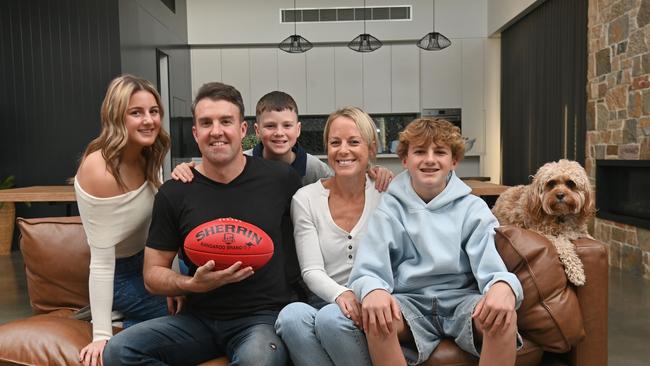
“John gave me opportunities, I started going okay and fell in love with the game again,’’ he said.
Sheedy was lured to Sturt in 2000 by Double Blues defender Seamus Maloney, who was an Imperials product and whose dad, Peter, was club president.
Arriving at Unley amid little fanfare and with low expectations, he would go on to become one of their finest players, winning the Magarey Medal as the SANFL’s fairest and most brilliant player in just his third year in the competition in 2002, when he tied with Sturt teammate Tim Weatherald.
Remarkably, the medal – won at age 22 – was his first ever individual award.
Three weeks later Sheedy was a SANFL premiership player after the Double Blues stunned hot favourite Central District at Football Park to win their first flag in 26 years.
“When I first came over it was really about whether I’d ever play league footy, to be honest,’’ he said.
“It was a big step up from the Sunraysia competition and I remember walking home from a party one night with Seamus and him saying, ‘I think you’ll play reserves quite comfortably and it would be a good effort if you could crack the league side’.
“In my first year of training in Adelaide I was working during the day and then going home to have a sleep before training, so it was a really big adjustment for a kid who had previously only trained a couple of times a week.’’
Sheedy spent 13 seasons at Unley, playing 255 league games.
Apart from winning the Magarey, he captained the Double Blues for six years from 2007-12, won four best and fairest awards (2004, 2006, 2008 and 2009) and was State skipper in 2008-09.
Off field, Sheedy had to deal with the horrors of the Bali bombings in 2002, which claimed the lives of reserves player Josh Deegan and trainer Bob Marshall while Sturt was enjoying its flag celebrations in the popular Indonesian tourist resort.
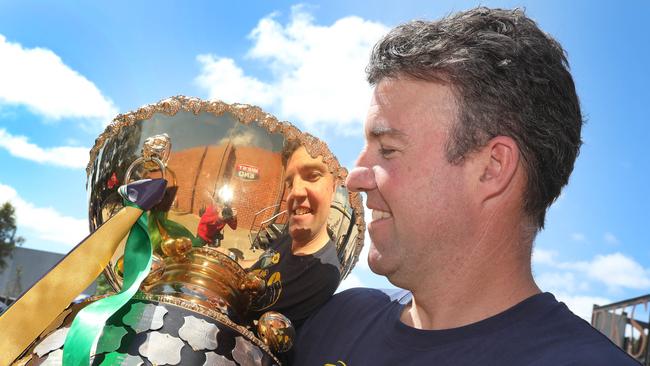
He was among a host of players who were hurt, having 40 stitches in the back of his head while also suffering burns to his hip and feet, but considers himself one of the lucky ones.
“I know if things had gone a different way I might not be here and that everyone has their own stories of what happened but the biggest tragedy is that we lost two great people in Bob and Josh,’’ Sheedy said.
When Sheedy retired from playing he had no intentions to coach, throwing most of his energy into his business, Sheedy Homes.
But in 2015, through family ties, he was lured into coaching Athelstone in the Adelaide Footy League and led the Raggies from Division 3 to Division 1 and a Division 2 premiership to become hot SANFL coaching property.
Woodville-West Torrens won the race for his services and – in his first two years at the helm – he led it to back-to-back flags for the first time in club history.
He also coached the SANFL State team twice, leading it to wins against the WAFL, before leaving the Eagles at the end of last season.
Asked about his stunningly successful journey, Sheedy, modestly, said it “all just unfolded’’.
“I try to be pretty relaxed about everything but I am a very competitive person,’’ he said.
“If you ask my mum, dad and brother, they would say I’m a bit of a psycho in terms of how competitive I am.
“I don’t like losing and have that real gritty determination to always try to be the best at whatever I do.
“I have that never give up attitude and everything I’ve done has just led to something else.
“I love the SANFL competition, both playing and coaching in it, and I guess it has all led to this honour, which is something I – and the family – are very proud of.’’
Crows’ Mr Consistency
Scott Thompson was the ultimate team player.
In his own words, his main objective as a footballer was “to contribute to the team’’.
He made an art form of it.
After growing up as a “mad Port Adelaide supporter’’, Thompson became one of Adelaide’s greatest players.
Consistency was his hallmark.
In 13 years on the Crows’ AFL list from 2005-17, Thompson finished in the top-10 of their club champion award nine times, winning the Malcolm Blight Medal as club champion in back-to-back seasons in 2011 and 2012.
The midfield ball magnet was third in the Brownlow Medal in 2012 and named an All Australian the same year.
He also is Adelaide’s greatest disposal winner, having compiled 6752 (3499 kicks and 3253 handballs) in his 269 games for the club – 28 more than his closest rival, dual Norm Smith Medallist Andrew McLeod.
Thompson’s individual success at Crowland was spectacular after he spent the first four years of his AFL career at Melbourne, which selected him from Port with the 16th pick at the 2000 national draft.
He played 39 games in four injury-riddled seasons with the Demons before requesting a trade to Adelaide and his home state at the end of 2004.
Thompson – a smiling assassin who played the game hard but fair – decided at age nine that he was going to be an AFL footballer.
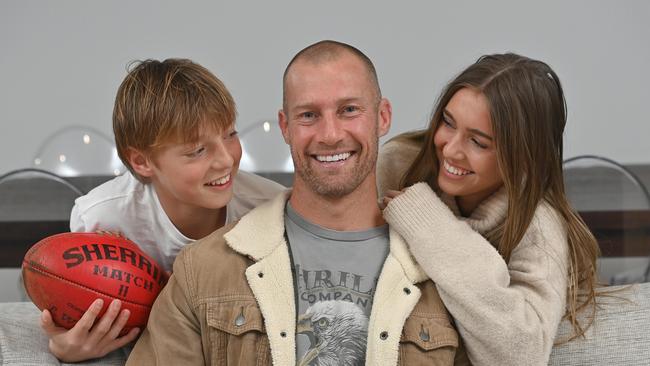
While he followed his family into the Grange Surf Life Saving Club, football was his true love.
He started playing for North Haven at age eight and progressed through the ranks, representing his school, St Michael’s College, before being selected in his first development squad at the Port Magpies in under-15s.
Thompson made the under-17 Australian side and South Australian under-18 team and his path was set, leading to his drafting by the Dees.
“The reason I started playing football was because it was a sport I loved playing with my mates and it took me on a fantastic journey right through my junior years, as a teen and then into my adult life,’’ Thompson said.
“That journey through adulthood went for 17 years in the AFL system, which I am very grateful for.
“All I wanted to do was prepare myself to give me the best opportunity of playing a certain brand of footy where I would be able to contribute to the team consistently.
“I never left any stone unturned to do that and always had the goal of making sure I was that team player who my mates could trust and knew what they were going to get from me. That was what I prided myself on.
“To be able to contribute to the Adelaide footy club the way I did was very rewarding.
“Accolades aside, I absolutely loved every minute of my time there and made some lifelong friends along the way.’’
Thompson retired at the end of 2017 after 308 AFL games in 17 seasons – the 74th most games played in VFL-AFL history.
Upon his retirement, then Crows coach Don Pyke paid tribute to the legacy he would leave at the club.
“Scott has been a true champion of the Adelaide Football Club and his achievements as a player are thoroughly deserved,” Pyke said.
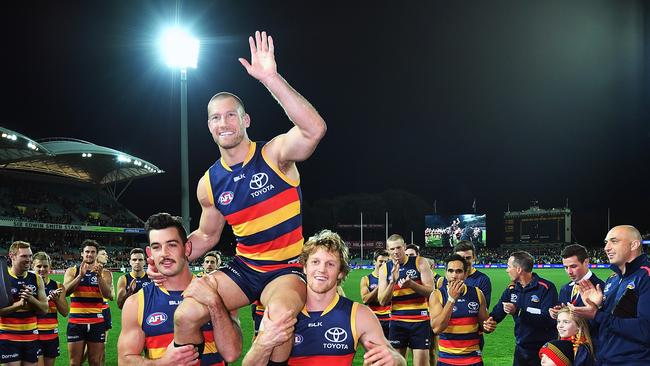
“From the day that he arrived at the club, he has been a fantastic leader both on and off the field who has helped those around him improve. To play at such a high standard for more than 300 games is a credit to him.”
While Thompson enjoyed enormous personal success, the one prize he desperately wanted – an AFL premiership, even a grand final – sadly eluded him.
He played in three losing preliminary finals for the Crows (2005, 2006 and 2012) and was overlooked for their losing grand final side against Richmond in 2017, when he lost his spot in the team and played just one game (in Round 16) for the season.
“I thought we had a team that was capable of going all the way a couple of times and, for whatever reason, it didn’t happen,’’ Thompson said.
“I loved playing finals and was always chasing that grand final dream but unfortunately it didn’t eventuate.
“Even now I’m envious of teams that make grand finals and win premierships because I wish I’d had that opportunity – to be able to achieve something special with a bunch of teammates.
“You don’t play footy for the individual stuff and I would like to be sitting here now saying ‘how good was that grand final that we won’, but unfortunately I can’t do that.’’
But Thompson, who currently coaches Unley Mercedes Jets in the Adelaide Footy League, can call himself an SA Football Hall of Famer after being inducted into the elite group this year.
“It’s certainly an honour and very humbling to have my name put alongside so many greats of SA football,’’ he said.



